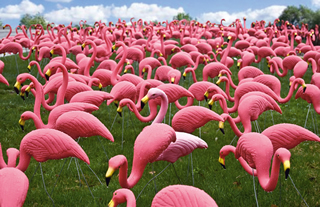Silly in Pink - Page 2
 |
|
|
 |
|
|
Price provides a treatise on how the concept of ‘pink flamingo’ has evolved in the mind and heart of Americans, from its original appeal to upwardly mobile working-class homeowners to its adoption by the camp generation, including Andy Warhol. In 1972 John Waters made the bird the centerpiece of his film Pink Flamingos, which made drag queen Divine a star, the city of Baltimore notorious, and ‘the filthiest people alive’ a title worth winning.
For middle-class folks and better, Price observed, “A plain lawn in front of a large house stated ‘affluent, but tasteful.’ But an unadorned swatch in front of a very small house said ‘inexpensive, and can't afford more.’
“Working-class consumers generally favored more conspicuous strategies to landscape their pieces of the American Dream…They found ample space for artifice. Many planted their lawns with squirrels, frogs, lighthouses, windmills, and flamingos.”
Featherstone himself acknowledged that his creation appealed strongly to working-class buyers, and was proud of it. In a 1997 interview, he spoke of earlier outdoor ornaments, bronze statuary. “But few people could afford such things. Keep in mind that, before plastics, only rich people could afford to have poor taste.”
“Let’s face it,” said Robert Thompson, professor of popular culture at Syracuse University. "As iconic emblems of kitsch, there are two pillars of cheesy campiness in the American pantheon. One is the velvet Elvis. The other is the pink flamingo.”
Phil Toy appreciates their aspect as camp. But his love for flamingos goes deeper.
“They’re a whole design icon of the ‘50s era,” he says. “Pink flamingos were really big in the ‘50s. They were in Disneyland, in amusement parks. Plus they were pink, and pink was big then. Marilyn Monroe wore pink. Pink was the rage.”
“My grandfather had a pink ’57 Cadillac sedan, a de Ville,” says Toy, who collects 1950s Cadillacs, Herman Miller furnishings, and other relics of the era. “That’s why I love Cadillacs.”
Nothing livens up a mid-century home more than flamingos, he says. “Throw in a few flamingos,” he says of his mid-century environment. “It ties it all together. It makes it even more fun.”
The metal legs of the flamingos are a true mid-century modern touch, recalling the simple metal rods that many furniture designers of the period used to make their creations appear to be weightless.
In fact, some design gurus argue, pink flamingos can be tastefully used for home décor. The ever-tasteful Dave LeBlanc, who writes the ‘Architourist’ column for The Globe and Mail in Toronto, acknowledged that modernists shun gewgaws in favor of purity.
“No tchotchkes, no overstuffed furniture, and outside, no coach lamps, no insensitive alterations to your mid-century classic, and definitely no lawn ornaments!”
But where’s the personality in a bare lawn, he wondered?
“I don't think lawn ornaments are silly if used in moderation. Mr. Featherstone's flamingos can add the right burst of color—mainly hot pink—to wake up a front yard and give passersby a chuckle.”
Pink flamingos not silly?
Not as silly perhaps as pink elephants, another of Featherstone’s creations. Featherstone, who went to work as a designer for Union Products in Leominster, Massachusetts, once called ‘the Plastics Capital of the World,’ produced many plastic animals over the years—“ducks, flamingos, penguins, gnomes,” he told an interviewer, “just about everything you could think of.”
“We manufacture a line of about 600 to 800 products,” he said in 1997, “and I sculpted every one of them.”
But none outclassed the flamingos, which were sold in pairs, male and female. Starting in the 1980s, to set them off from a horde of imitators, Union-produced flamingos were marked with Featherstone’s name.




